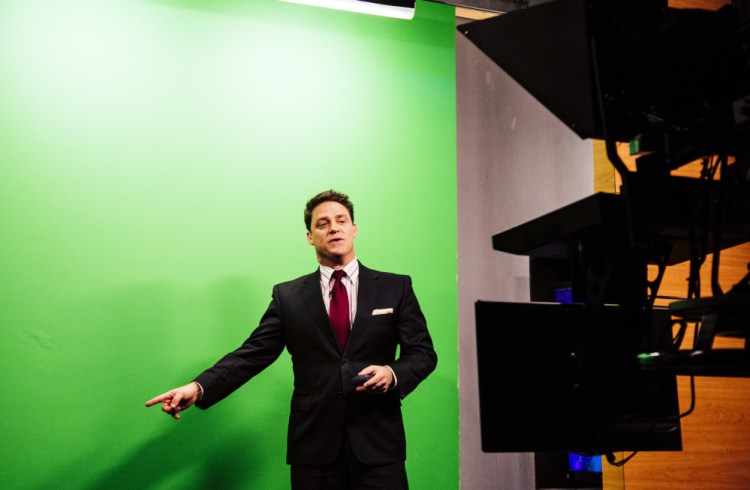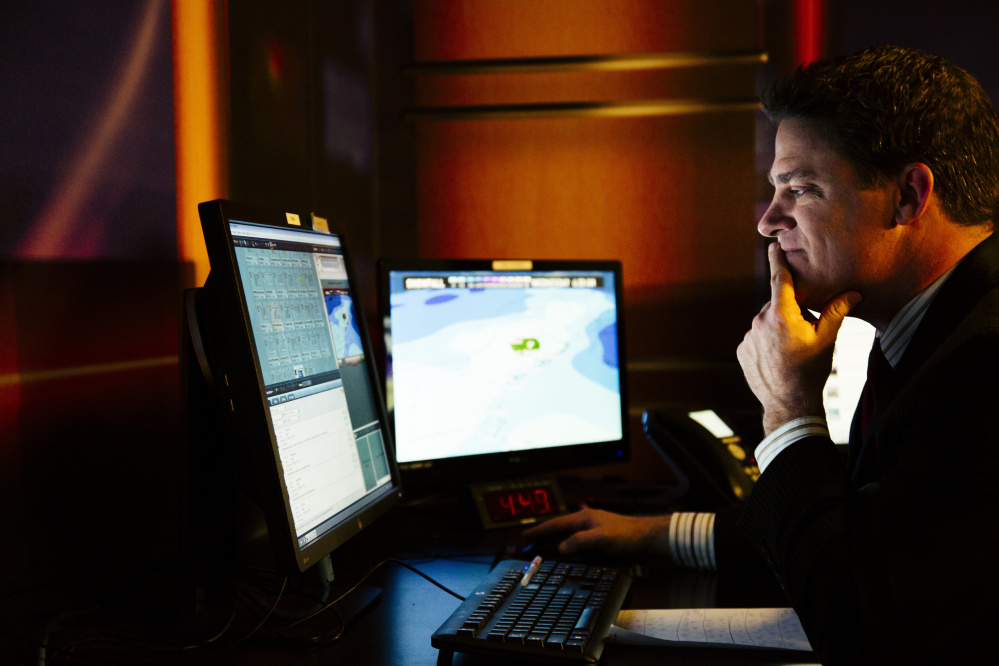Weather forecasts are a lot like first impressions: They stick in your mind and can be tough to shake.
Maybe that’s why people in southern Maine were talking Monday about a “blown” forecast by local meteorologists. Greater Portland received 2 to 3 inches of snow, but the conventional wisdom among many folks was that only a dusting had been predicted.
Was the forecast really blown? Or did people just get their information from a long-term prediction five days earlier? Or maybe they misread the tiny numbers on one of their half-dozen mobile weather apps. Or maybe they got their details from a blog post that was compiled by a 10-year-old weather buff and shared by a friend on Facebook.
So much weather information is available today, at the touch of a finger and on so many devices, that people have come to expect on-demand perfection. If we can Google “Donald Trump’s birthday” and get the correct date (June 14) in a millisecond, why should weather reports be any different?
Many outlets were predicting Tuesday that a “major” snowstorm will hit the Northeast this weekend. The storm may or may not hit here, but the prediction has been made, and it will certainly stick in more than a few minds.
“The availability of so much data has really changed the way people think about forecasts,” said the Weather Channel’s Keith Carson, who worked at WCSH-TV in Portland until 2013. “There are so many people pushing out forecasts now, and not all are degreed meteorologists. Some forecasts come out, with snow totals, seven or eight days in advance. For a lot of people the first (forecast) they see is the one that sticks with them.”
UNPREDICTABILITY HASN’T CHANGED
As for Monday’s storm, an AccuWeather.com forecast that was compiled Sunday and appeared in this newspaper Monday called for 1 to 2 inches of snow. The National Weather Service said 2.5 inches fell Monday in Portland. So was that a blown call? Or was it just within the normal margin of error for Mother Nature?
Just because we have so many more ways to access data doesn’t mean that the unpredictable nature of weather has changed. Forecasters might call for a day of no snow because temperatures are around 40, but then ocean moisture and various air pressure conditions create snow anyway, Carson said. As far as long-range forecasts, Carson says he wouldn’t attempt to predict snow totals even generally, like “area of heaviest snow” or “area of lightest snow,” until four days before a storm.
Then there are the computer models, the half-dozen or so simulations of atmospheric conditions that meteorologists use daily. Some come from Canada, some from Europe, and some from the Navy. And some days they all say different things.
“We look for trends, but sometimes you compare the models and we say, ‘This one’s way out to lunch,'” said Tom Hawley, a meteorologist at the weather service office in Gray who has 32 years of experience.
The weather service updates the forecast every six hours, and conditions can change within those windows, Hawley said.
SATURDAY FORECAST ONLY OFF A BIT
Another case of people complaining about a blown forecast happened Saturday, when heavy snow fell rapidly on Greater Portland for two or three hours. But was it a blown forecast? Or was it a case of too much information too soon?
Last Thursday, the weather service issued a forecast for coastal Cumberland County and Westbrook saying that Saturday would bring rain and sleet, or snow, with “little to no accumulation.” But on Friday, at 3:26 p.m., the service’s report for Saturday called for sleet and snow in the morning and snow in the afternoon, with a total accumulation of 4 to 6 inches.
The forecast was off slightly, as it started snowing heavily in the morning. But the recorded snowfall for Saturday around southern Maine was 3 to 6 inches, right within the predicted range. The measured amount in Portland was 3.5 inches.
Still, it’s hard for people to sort out all the various reports and find the one that turns out to be most correct.
“The thing I don’t like is when there’s a storm 4,000 miles away and they’re telling you exactly where it’s going to hit. How do they know that?” said Russ Lunt, a retired South Portland snow plow driver. “When I was plowing we always lived by the forecast, but I think it was simpler 30 years ago when we only had three stations giving forecasts. Today I’ve got all these apps, and they don’t always say the same thing. The weather used to be easier to follow.”
Lunt also wishes meteorologists wouldn’t “sensationalize” the weather by making every storm seem like “we’re going to be locked inside for three days.”
“This is Maine,” he said. “We’ll deal with the weather we get.”
CONSTERNATION AND CONFUSION
Karen Arel, president of the Ogunquit Chamber of Commerce, laments the abundance of long-range forecasts. She says people will see a forecast that calls for rain 10 days away and then change the plans they had to visit a lovely Maine beach.
“(Forecasters) start out the week before saying it’s going to rain, then it’s 85 and sunny,” Arel said. “I know they’ve got their satellites and this and that, but it seems like a guessing game.”
It’s a guessing game for the consumers of weather information, who can’t remember where they heard a forecast they didn’t like, so they guess.
Tom Johnston, a meteorologist at WCSH, posted online last week that zero to 3 inches of snow would fall Monday across Maine. That range was spot on. Yet someone sent him an electronic message that said, “So much for flurries.” Johnston never mentioned flurries.
Maybe the best way to avoid forecast confusion is to stick with one trusted source, and then be prepared to deal with the weather you get, as Lunt suggests.
FORECASTERS ‘DO THE BEST THEY CAN’
June Langlois of Limington, a self-described “weather buff,” has a weather band radio and gets her forecasts by tuning into the broadcasts of the National Oceanic and Atmospheric Administration. Langlois, 71, used to do some “self-sufficient” farming when her children were young, and the weather became important to her.
“I like NOAA because they give you a percentile, 70 percent chance of something happening, so you can prepare,” Langlois said. “Weather is very interesting to me, but I don’t think anyone can really predict (it). I think they do the best they can with what they’ve got.”
What they have, in terms of equipment and data, allowed weather outlets to announce Tuesday that a big winter storm would hit the Northeast this weekend. Most of the details, including snow totals, duration and the areas that could be affected, will come later.
But one important detail, a sign of how hyped and frenzied the world of forecasting has become, is in place. The Weather Channel already has named the storm: Jonas.
Send questions/comments to the editors.





Success. Please wait for the page to reload. If the page does not reload within 5 seconds, please refresh the page.
Enter your email and password to access comments.
Hi, to comment on stories you must . This profile is in addition to your subscription and website login.
Already have a commenting profile? .
Invalid username/password.
Please check your email to confirm and complete your registration.
Only subscribers are eligible to post comments. Please subscribe or login first for digital access. Here’s why.
Use the form below to reset your password. When you've submitted your account email, we will send an email with a reset code.